Translate This Page
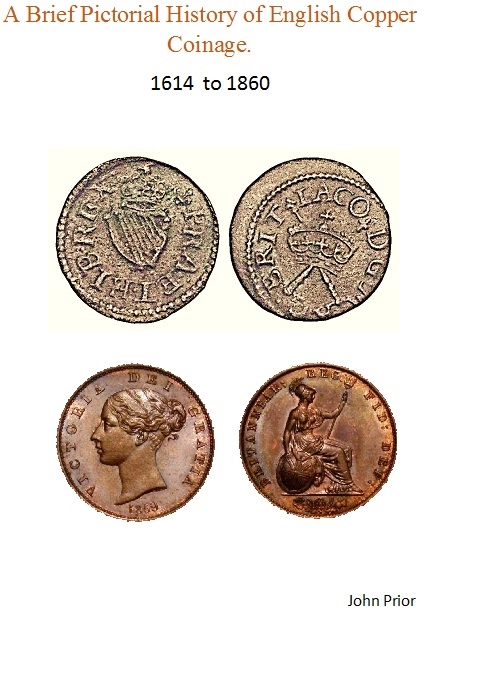
FOREWORD
It was been estimated that as many as three per cent of the pound coins in circulation in 2014 were counterfeit. This represented £50 million of counterfeit coinage in the UK.
Since coins were invented people have attempted to copy or debase them to make themselves rich. This book examines the development of English Copper coinage, the way it has been affected by corrupt practices, the history associated with the coinage and the insight provided into 18th Century society by the coins minted.
John Prior (Ed)
2020 ©
A Brief Pictorial History of English Copper Coinage.
1 Origins and manufacture.
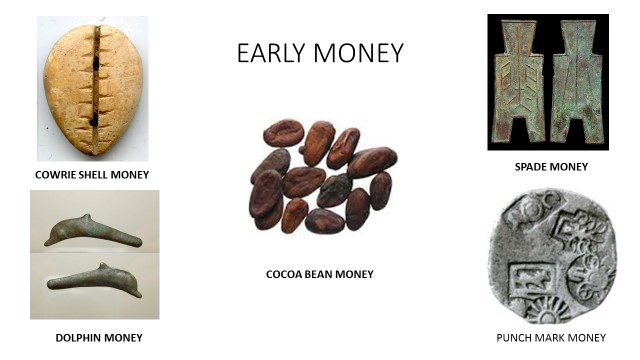
Before discussing the development of English copper coinage it is worth considering the origins of coinage and the way in which it was first manufactured.
Money has not always been little round disks of metal!
Coins are of course nowadays used as a measure of the value of goods.
However in the many cultures and ages of the world different, difficult to obtain, and desirable objects of various types have been used to enable transactions to take place between people.
One of the earliest mediums of exchange were sea shells. From 2000BC Cowrie shells were used in China, initially genuine shells then, later, copies in bone and in china. Shells were widely used in other parts of the world.
The picture shows Dolphin money (2 cm long) bronze coinages of the Black Sea area. Around the city of Olbia on the north coast of the Black Sea large numbers of tiny, cast bronze dolphins have been discovered. They are sometimes found in groups, and in several instances have been discovered in tombs in the hands or mouths of the dead. These facts, together with the appearance of the dolphin on later coins of the city, make it clear that the bronze dolphins had a monetary use and were used in the 5th Century BC.
We don’t know when cacao beans began to be used as money in ancient Mexico, but we do know they were widely used as money in Aztec times. Their use continued with even after the Spanish conquest and then through the Colonial period.
In India punch mark money (1cm in diameter.) was made in which small silver pieces were impressed with symbols representing the value and the issuer. The sample illustrated is 5-6th century BC Indo Ganges plain -North of India just south of the Himalayas. The particular marks indicate the Kingdom of issue.
The Chinese were an agricultural country and they used models of their tools as money. The picture shows Chinese Spade money dating from 1200-800 BC (6cm long)
These diverse measures of value eventually gave way to the little round discs we use today.
.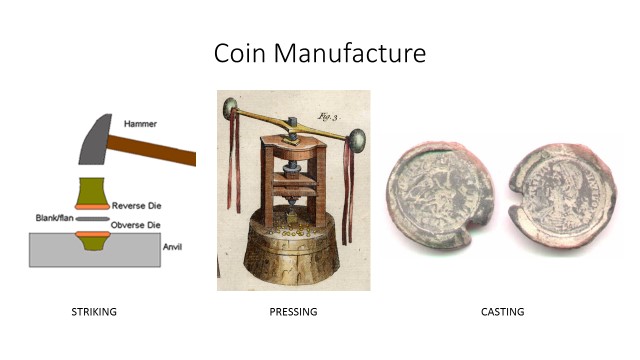
Coins are made by impressing a die onto a blank circular piece of metal usually called a Blank or Flan or Planchet. Impressing was done by impact, as the Romans did, and later, as now, by pressing.
Ancient counterfeiters often used a coin to create a mold with which to cast counterfeit coins by pouring a metal into the mold.
Counterfeiters generally use sub- standard metal to make coins but even kings from time to time debased the currency with base metals to raise revenue without appearing to raise taxes.
Getting the Balance Right
- Metal cheaper than the coin value - Profitable for counterfeiter
- Metal dearer than face value – Melt down coins and sell the metal.
2 English Copper coins
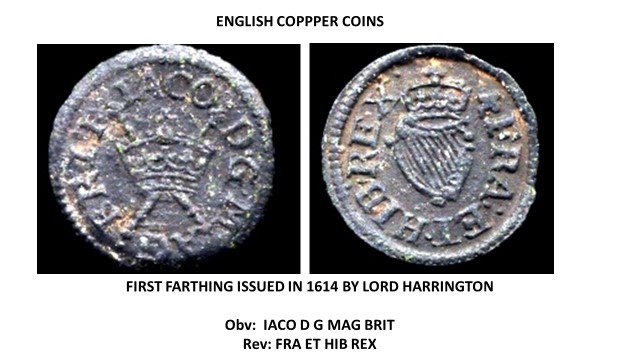
This book is about English Copper coins.
The picture above is of one of the first English copper coins ,a farthing. Engraved – In Latin- James, by the Grace of God King of Great Britain France and Ireland.
Early English silver and gold coinage was issued by the royal mint and in principle the intrinsic value of the coins was closely tied to the face value of the coin.
Copper coins were not popular with Kings and they did not like the Royal mint working in copper. It was thought that copper was not a proper metal for Regal coinage at all, and, therefore, that copper coinage was not an important activity for the Royal Mint to pursue.
The first English copper coinage was issued in the Reign of James I who was King of Scotland from 1567 and of England and Scotland from 1603-1625. He decided that a low value coin was necessary to prevent individual towns and tradespeople creating their own copper coinage to make small payments, and he imported the idea of copper coins from Scotland where of course he had been King for some years and where copper coins had been in use for some years.
The king issued a contract to his friend Lord Harrington to produce 90,000,000 copper farthings in a private works. Harrington was to pay a high fee to the King for the right to mint the farthings, but despite this, was going to make a healthy profit on the deal. The king calculated that they would have a circulating value £90,400, but would cost only £25,450 to strike.
Harrington was to be allowed £25,000 profit for his work, and the remaining profit would go to the King! Actually, he came no way near producing this number of coins.
Harrington died in 1613 and the right to produce farthings passed successively to Lord Lennox then other members of the nobility. James died in 1625 and was succeeded by Charles 1. Then, in 1634, another farthing patent was issued to Lord Maltravers.
During the next two years there were vast numbers of counterfeit farthings in circulation and the situation became unacceptable as, with poor quality Regal farthings and many counterfeit coins, the poor felt unfairly treated by the authorities because they were used to dealing in coin that was worth its face value.
Maltravers tried to overcome the counterfeiting problem by making the coins harder to mint. His coins had an inset of brass. It is believed that a rod of copper was produced with a notch in it, and then molten brass poured into the wedge, finally the rod was sliced to create the blank planchets producing coins as shown below.
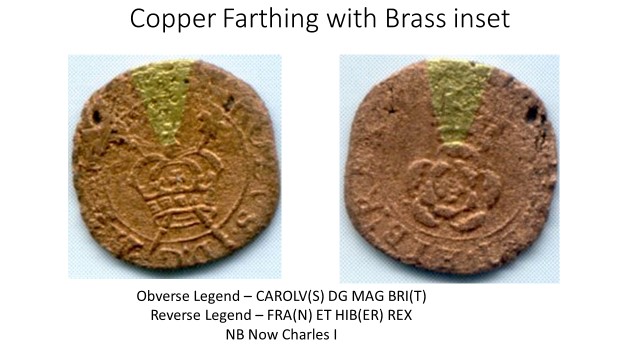
Maltravers Rose Farthings, above, were issued from – 1636 to 1644.
The issue ceased in 1644 because there were so many genuine and counterfeit farthings in circulation and Copper coinage only became properly re- established in the Reign of Charles II in 1672. ie 28 years later.
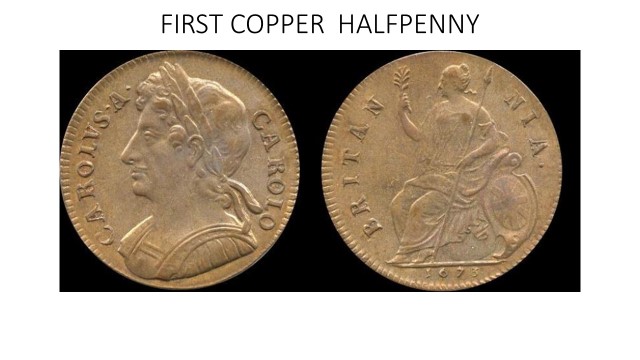
On Thursday August 1, 1672, Charles II announced the government would begin making copper small change coins in a proclamation entitled "A Proclamation for making currant His Majestie's Farthings and Half-pence of Copper, and forbidding all others to be used" .
With the change from hammered coinage to the use of the screw press the king hoped to be able profitably to make a sufficient number of small change coppers for the country.
The copper content was worth about half the face value of the coin. As such, these coppers were the first royal coinage to have an intrinsic metallic value less than their face value. ( which of course encouraged Counterfeiting).
Because the copper used per coin was worth less than the coin they were technically considered to be tokens rather than coins and so were declared to be legal tender only in amounts of six pence or less. No one was obliged to accept more than twelve halfpence per transaction.
The figure of Britannia on the coin was said by Samuel Pepys to have been modeled on Frances Teresa Stuart, the future Duchess of Richmond, who was famous at the time for refusing to become the mistress of Charles II, despite the King's strong liking for her. 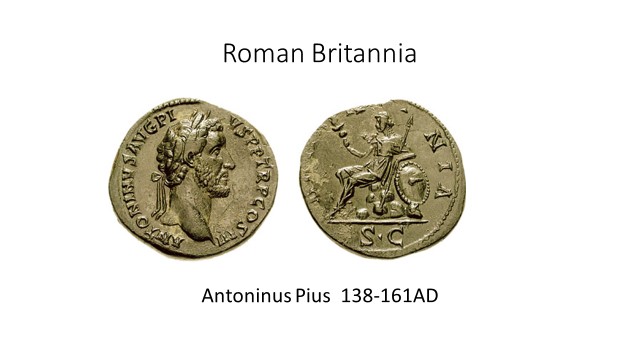
Almost 1,500 years earlier the figure of Britannia had been on the coins of the Roman Emperors. On the Charles II halfpenny Britannia made her re-appearance shown seated on a rock, facing left, with an olive branch in her right hand, a spear in her left hand, ( NB From 1797 onward she had a trident to emphasise that we are a Naval power ) and a shield leaning against the rock. The English coin shield bears a Union flag. The design of this portrayal of Britannia are clearly inspired by the earlier Roman Britannias. She stayed on British coinage in until 2008. Then, for the first time in over 300 years, she no longer featured on British circulating coinage.
Under Charles II the contractors minting the coins were salaried, so that profits went to the king. But in the Reign of William and Mary, 1689-94, the entire operation was licenced to a company who would suffer any loss or gain any profit from the activity. Basically the work was privatised! They economised in the way the planchets were produced by casting them rather than cutting then from sheet copper. This made a less uniform product with a pitted surface. During this period a large number of coppers were produced but of poorer quality workmanship.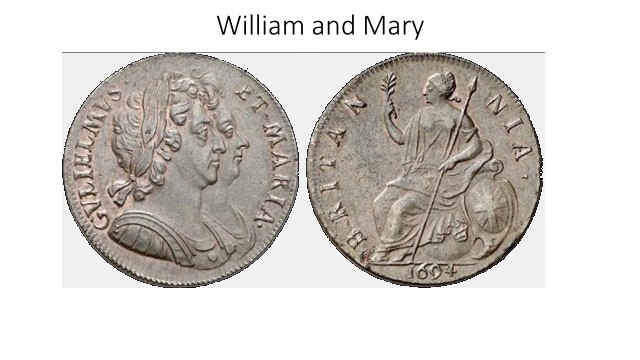
Also although the authorized halfpenny weight remained 42 halfpence to the pound (166.7 grains), the actual coins were often much lighter making more profit for the contractor.
William and Mary displayed both of their profiles on their coins, using the bust facing right for all denominations. After Mary died of smallpox, William III ruled alone (1694-1701).
In thanks for his other achievements, Isaac Newton was appointed to the post of warden of the Royal Mint in 1696. Although the post was intended to be a sinecure, Newton took it seriously. Newton's chemical and mathematical knowledge proved of value to the mint. Newton was subsequently given the post of Master of the Mint in 1699, a post worth between £1,200 and £1,500 per annum.
When William died, under Queen Anne (1701-1714) no circulating halfpence were produced because so many were already in circulation.
In the last year of her reign the London mint master, Isaac Newton, oversaw the production of a few farthings, most of which were proofs, but a few may have been made for circulation. These coins were slightly smaller that William's farthings but of a much higher level of craftsmanship. Newton produced a more uniform product with less of a weight range between examples and sharper reliefs on the images.
By the reign of the first Hanoverian, George I (1714-1727), there was once again a need for more coppers. In 1717 a royal warrant proclaimed a new halfpenny would be issued by the royal mint.
Halfpence and farthings were produced that were somewhat smaller in diameter but thicker than earlier issues. This was known as the Dump issue.
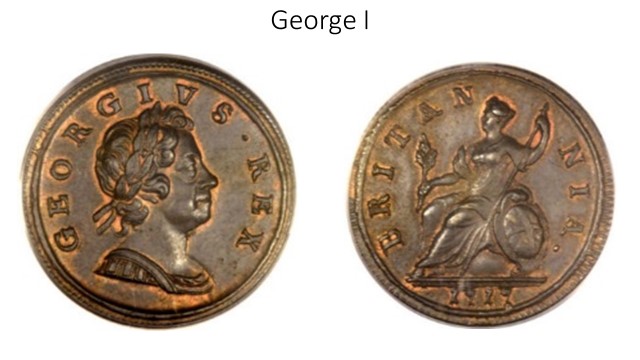
3 The Counterfeiting Problem
During the early part of the thirty three year reign of George II (1727-1760) a large number of copper halfpennies and farthings were produced. However, a number of illegal counterfeit coining operations opened at this time, producing a large quantity of underweight coins.
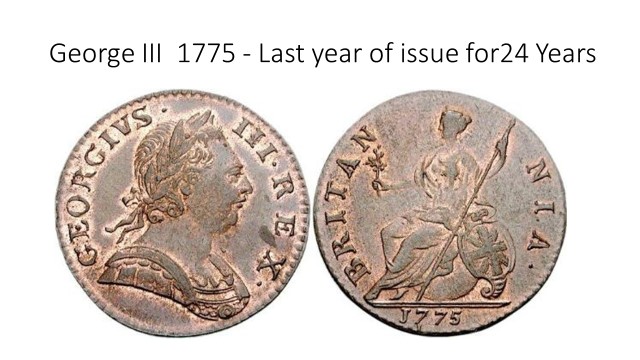
Then due to higher copper prices and the significant number of counterfeit coppers in circulation no Regal coppers were produced during twenty four years of the reign of George III (1760-1820) after 1775.
The reason that Geo III stopped minting coins was because he found that they were not much used. There were two main reasons for this . The huge number of counterfeit coins in circulation would be spent first — if the holder could get anyone to accept them. The nice, new, shiny coins would be saved. The second reason they were not used was the counterfeiters, who would gather up the new issues, melt them down, and make 2 or 3 lightweight coppers out of one good one — thus doubling or tripling their money. Obviously, this latter only added to the counterfeits in circulation During this period the number of counterfeit halfpence significantly outnumbered the Regal issues.
The figure show a typical counterfeit coin at the top . The obverse bears a portrait of George III while the reverse bears a Britannia design. This halfpenny was at least 25% under the minimum acceptable weight of 140 grains. The obverse has a noticeable pointed nose bust, with the nose pointing to the vertical stroke of the R. Also the S in GEORGIVS is slightly separated and in REX the E and X in REX are also distant with the end on the X and the final stop very close to the bust.

Britannia's hand points between the I and T and the top leaf points to the corner of the N. The bottom of the pole points to the right of the 1 in the date.
By 1770 it was estimated that no more than 40% of the coin in circulation were genuine. By 1771, the problem was becoming unacceptable, so laws were passed making the manufacture and passing of counterfeits an imprisonable offence.
Magistrates were empowered to order searches, and to destroy coining machinery. This led to there being a significant reduction in counterfeiting.
The laws against counterfeiting however, had a loophole.
4 The Evasion Problem
The laws were written to cover Regal coinage. If a coin was made that was not an EXACT COPY of the Regal coin, it was considered to be a token, and the law did not apply.
Thus, the counterfeiters simply switched from making counterfeit Regal coins to making “Evasion” token coinage that looked somewhat like the Regal coin.
These coins usually had a bust on the obverse — often a likeness of King George III, or some other well-known figure — and a seated Britannia or a harp (for Ireland) on the reverse.
The legends were often invented. Instead of “George III Rex,” the obverse might have “George Rules”.
It was not long before this innovation lead on to a flood of copper Evasion coins that had a similar design to the coins of the realm but on closer examination were seen to be Tokens.
Three examples of Evasion Tokens are shown below
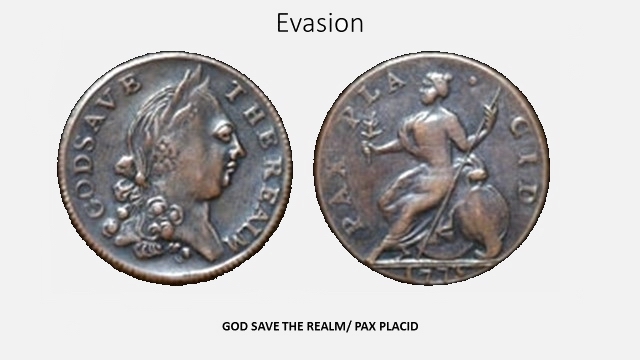
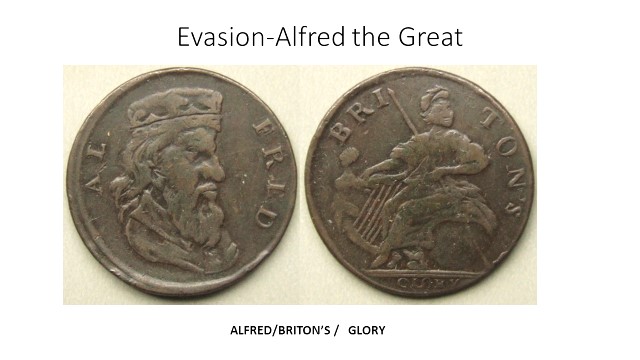
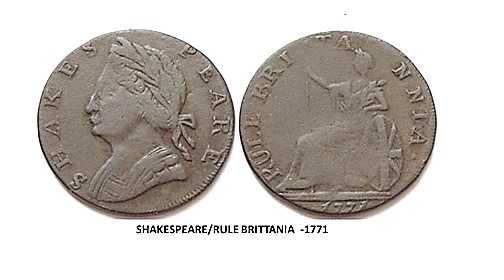
5 The Industrialisation Problem
England managed with previously issued Regal coinage and evasion coinage from 1775 until 1787, then there was a significant change.
As the Industrial revolution began to affect a wide range of activities labourers saw an opportunity to leave the farm, and make a living wage for their families.
There was thus a steady movement of people from the provinces to mining or large manufacturing centres. There, the need to pay wages was hampered by a lack of small coin. Some of the coal mines were located in remote areas, and there was just not enough change available. In the cities, with more and more workers getting wages, more shops of all sorts were opened, bringing with them more jobs that needed wages to be paid. The large cities often had enough of small value coin. It was true that most of it was “bad” (non Regal coin) , but at least it existed. The small towns out in the “provinces” were often completely without coin. Money tended to flow to the major trade centres, and never returned. All of this began to occur increasingly by the mid 1780’s creating a major problem for companies and workers.

Parys mountain is the site of a large copper mine that was extensively exploited in the late 18th century. The mountain was mined for copper ore in the early Bronze Age, as shown by sub-surface debris nearly 4,000 years old . Parys Mountain dominated the world's copper market during the 1780s, when the mine was the largest in Europe. The copper from the mine was used to clad the British Admiralty's wooden ships of war, to prevent the growth of seaweed and barnacles.
In 1787, the Owners of the Parys Mining Company saw a way out of the coinage problem. Located in Anglesey, Wales, they were out of the mainstream. Little coinage of any kind found its way there. They had the copper so Planchets for copper coins could now be made locally, at reasonable cost and they had access to coining presses in Birmingham. They decided to make their own coinage for themselves and in response to the national shortage of small currency.
Beginning in 1787, they produced Penny and Halfpenny tokens, of the correct weight, nice design, and an edge legend that stated they were repayable in Regal funds by them. They were keenly accepted by the workers, and welcomed by the merchants.
The Parys Mine Company produced its own coinage between 1787 and 1793. The Parys Penny, also known as the Anglesey Penny, was not only used by the mine to pay workers, and also by the populace at large. It is thought that around ten million pennies and half pennies were minted.
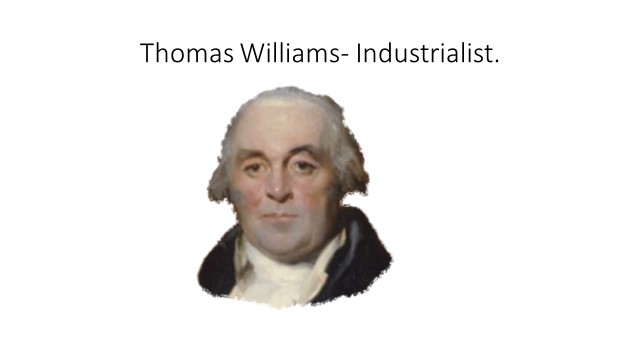
The man behind all this was a North Wales lawyer, Thomas Williams, the owner of the Anglesey Mines. Williams was only too aware of the severe cash handicaps which hampered newly- evolving industrial communities. He decided to set up a business of minting coins, initially to pay his workers, but it expanded well beyond that. Thomas Williams legal work had led to the formation of the Parys Mine company in 1774 and he became interested in the mine. He formed alliances and eventually gained control of the Anglesey and the Cornwall copper mines. Thomas had copper warehouses in London , Birmingham and Liverpool. He established smelting works in coal fields on South Wales and Lancaster He gained an industrial and commercial stranglehold over the entire British copper trade. He became widely known as the 'Copper King‘.
By the later 1780's, the mining operation (an open pit affair, conducted by blasting away the ore-rich face of Parys Mountain with gunpowder) was employing well over a thousand men locally, and many more at its rolling operations at Holywell, Flintshire.

Thomas Williams lived at Plas LLanidan overlooking the Menai Straits. His home was close to the battle fields of the Romans and Druids in AD61 and AD76. Maybe this influenced the design of his first coin with its Druids head..
The reverse of the coin showed a PMC design which stood for the Parys Mining Company. WE PROMISE TO PAY THE BEARER ONE PENNY The design also had the words:- Payable on demand in London , Liverpool or Anglesea.“ on the edge.
This served as a reminder that the coins were "Trade tokens" and not official coins of the realm.
The Universal Register a London based newspaper of the time, reported in March 1787:-
" There is a new coinage now going on in the Isle of Anglesey at the great copper mines there. It is struck upon copper and is intended only for the convenient of paying their men. The die is most beautifully conceived and executed and the intrinsic valve of the copper is nearly a penny.”
Initially the blanks for these coins were cut at Thomas William's works at Greenfield near Holywell in North Wales. They were then sent to William's presses at Great Charles street in Birmingham to be cut and finished. It has been estimated that 250 ton of pennies and 50 ton of half pennies were struck at these works. This amounts to over 12.5 million coins. Each ton was equivalent to 35840 pennies or 71680 half pennies which is around £150.
Thomas Williams continued to mint his own coins until around 1790 when he entered into an agreement to allow the Industrialist Mathew Boulton to mint the coins for him at his works at Soho in Birmingham.
Over the next 10 years the Thomas Williams trade tokens became widespread in their use not only in Anglesey but throughout the rest of the country. The final trade tokens were struck by Mathew Boulton in around 1798. After this Boulton had won the contract to supply the crown with a coin of the realm and the PMC coin was discontinued.
Manufacturers and artists joined in with enthusiasm producing designs that were not possible until improvements in coining manufacture techniques, due to the industrial revolution, made it so. The need for correct weight coinage existed, and there were lots of people willing to fill the need.
The idea spread, and by 1795 thousands of issues of tokens could be found. Due to the improvement in the way tokens could be manufactured, the commercial tokens were not only of the correct weight, but could be made with artistic designs. About 95% of the tokens produced were halfpennies.
Penny tokens were generally produced in small number. For a ten year period extending from 1787-1797 almost the only “coins” in circulation in Britain were the Provincial, or tokens.
As they were designed and manufactured by the public, they were not limited by any rules or regulations. The tokens now tell a history of a people in a unique way. Through them, we can see a description of life in late 18th century Britain. We can see how they lived and worked through their commerce, politics, advertising, and even view their architecture

This is the man who worked with Williams. Matthew Boulton (1728-1809) is one of the most important historic figures associated with the city of Birmingham. During his lifetime Boulton was a world-famous figure, but since the twentieth century his name has been largely overshadowed by that of his business partner, James Watt, of steam engine fame. But without Boulton’s vision, and enthusiasm it is unlikely that Watt would have succeeded so well as an engineer and inventor.
Boulton’s work as well as Watt’s pushed the technological boundaries of his time and led directly to Britain becoming the world’s first industrial nation, something which has shaped our lives ever since.
Boulton was not the first coiner of tokens, nor the most prolific. During the peak period of token issuing, he and his mint struck tokens for seventeen customers in the British Isles, to a total weight of around seventy tons. This compares with the three hundred tons of tokens struck by Thomas Williams for the Anglesey Mines, and the tokens struck by Lutwyche, another Birmingham coiner, who minted 65 tons of tokens for sixty or seventy customers.
But the tokens Boulton made were definitely the most important, not just in Birmingham, or even in England, but in the world, because they were the incentive for the development of industrial minting techniques.
Mathew Boulton had turned his attention to coinage in the mid-1780s as an extension to the small metal products he already manufactured in his factory in Soho Birmingham. In 1788 he established a Mint as part of his industrial plant. He invented a steam driven screw press in the same year
He installed eight of these state-of-the-art steam-driven presses in his factory, each with the capacity to strike between 70 and 84 coins per minute. The firm did not have immediate success in getting a license to strike British coins, but was soon engaged in striking coins for the British East India Company, Sierra Leone and Russia, while producing high-quality planchets, or blank coins, to be struck by national mints elsewhere. The firm sent over 20 million blanks to Philadelphia, to be struck into cents and half-cents by the United States Mint.
Initially Boulton used Cornish copper but after his agreement with Williams he also used De Parys copper.
These were the first modern coins; Boulton also pioneered special methods to frustrate counterfeiters. The coins featured a raised rim with lettering impressed into it. They also have lettering on the rim.
Boulton was finally awarded a contract by the Royal Mint in 3 March 1797 and between 1797-1799 alone, minted c.45 million pennies, two-penny pieces and halfpennies,
Boulton was a supporter of the campaign against slavery. In 1789, along with Joseph Priestley, he joined the deputation to welcome Olaudah Equiano, who came to speak in Birmingham about his experiences as a slave.
Matthew Boulton died of kidney failure at Soho House, Handsworth, on 17th August 1809. James Watt died on 25th August 1819 and was buried beside Boulton in St Mary's Church on 2nd September.
6 Tokens and Society
There are many hundreds of different tokens issued in the 10 years from 1787 to 1997. They were issued for a multiplicity of reasons - to promote Industries, Causes, Politics, Places and People, as illustrated in a few examples below.
INDUSTRIAL TOKENS
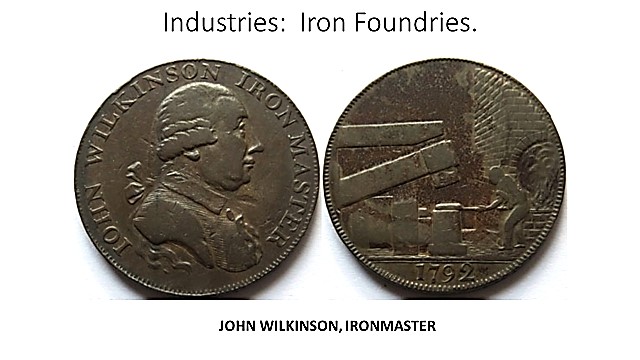
Obverse: Bust of John Wilkinson with legend: “IOHN WILKINSON IRON MASTER”. Reverse: The interior of a smithy showing a large drop hammer and a workman holding a piece of metal on an anvil in front of an open furnace with the date: “1792” in the exergue. Edge inscription: “WILLEY SNEDSHILL BERSHAM BRADLEY
John Wilkinson was one of the major forces behind the construction in 1779 of an iron bridge, a 30-metre (100 ft) cast iron bridge that was built across the River Severn at Coalbrookdale.
It was the world's first iron bridge, and is now a major Tourist attraction and part of a UNESCO World Heritage Site.
In 1787, Wilkinson launched the first iron barge. His iron obsession reached its peak in the late 1790s, when he paid to have iron windows, a pulpit and other fittings installed into a Methodist chapel in Bradley. He was known as 'Iron-Mad Wilkinson‘ .
John Wilkinson and his brother William joined up with James Watt in the manufacture of steam engines. For some twenty years they enjoyed a near-monopoly, with Boulton & Watt insisting that customers bought parts from the Wilkinson foundry.
Wilkinson soon copied Williams in minting his own coins and between 1787 and 1798 his money was circulated in several Midland, Western and Welsh counties.
Wilkinson, like others had to do this due to the lack of small change but possibly he saw a great opportunity for self-advertisement, for while Williams, Reynolds, Darby and others merely mentioned their companies (Parys Mines Company, for example, in the case of Williams) Wilkinson, alone of the industrial token issuers, had his own effigy stamped on his coins, together with the words - JOHN WILKINSON, IRONMASTER - ! The only faces to appear on British coins of the 18th century is that of the monarch, and John Wilkinson.

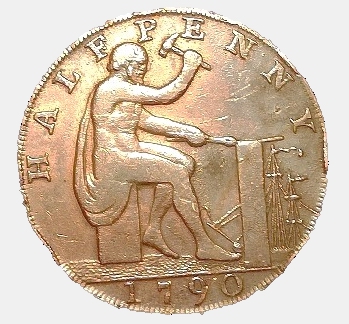
John Wilkinson died in 1808 a wealthy man. He was buried in an iron coffin.
IRON FOUNDRY

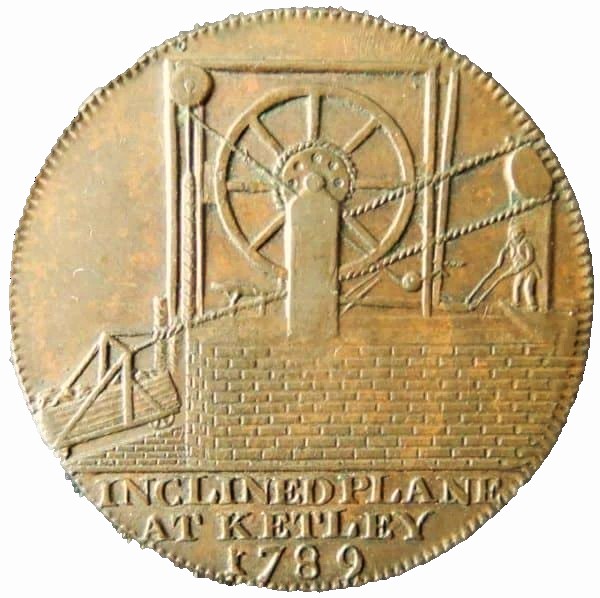
The picture shows a Coalbrook halfpenny token dated 1792. Obverse: Detailed view of the bridge with a sailing ship passing underneath: "IRON BRIDGE AT COALBROOK DALE. 1792", "ERECTED ANNO 1779. SPAN 100 FEET". Reverse: A man working at a barge-lifting machine: "INCLINED PLANE AT KETLEY. 1789". Edge inscription: "PAYABLE AT COALBROOK-DALE AND KETLEY".
Issued by Reynolds & Co., trading as the Coalbrook-Dale Iron Company with establishments at Coalbrook-Dale and Ketley.
Ketley Iron Works
In 1754 Abraham Darby (1711-1763) had recently become lessee of the coal and ironstone near Ketley. Two years later he leased land next to Watling Street for an ironworks. The first furnace came into blast in 1757 and a second in 1758. The area around Ironbridge is described by those promoting it as a tourist destination as the "Birthplace of the Industrial Revolution". This description is based on the idea that Abraham Darby perfected the technique of smelting iron with coke,(rather than using charcoal from wood) in Coalbrookdale, allowing much cheaper production of iron. 1796 Joseph Reynolds was the managing partner of the Ketley Iron Works, Shropshire. He and William were sole partners. Under the Reynolds brothers Ketley was the fifth largest ironworks in Britain .
This company cast the 278 tons of iron used in the construction of the bridge. Also, Reynolds invented the inclined plane on the reverse which was used to haul barges 60 feet up to the next level of canal at Ketley where locks were not feasible. It was powered by the barge-lifting gear situated at the top of the slope, as indicated on the token.
MINING
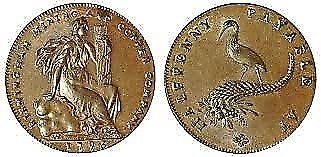
Obverse: Birmingham Mining and Copper Company Female in classical dress seated on a rock facing right, left hand holding fasces, right hand on rock.
Reverse: A stork facing left standing upon a cornucopia
Lettering: HALFPENNY PAYABLE AT
Edge Lettering BIRMINGHAM LIVERPOOL OR LONDON
A trade token of the Birmingham Mining and Copper Company. After the failure of various schemes to provide Birmingham with its own copper smelters, the manufacturers set up the Birmingham Mining and Copper Co on similar lines to the Birmingham Metal Co, with smelting works at Swansea. Its formation was part of the reaction in the Midlands against the monopolistic practices of the Anglesey and Cornish mining interests led by Thomas Williams.
Wool Manufacture
Bradford was once known as Worstedopolis due to the number of mills and wool processing businesses including wool-combers that operated in the district .
Anglesey, Parys Mines, Copper Halfpenny, 1791,

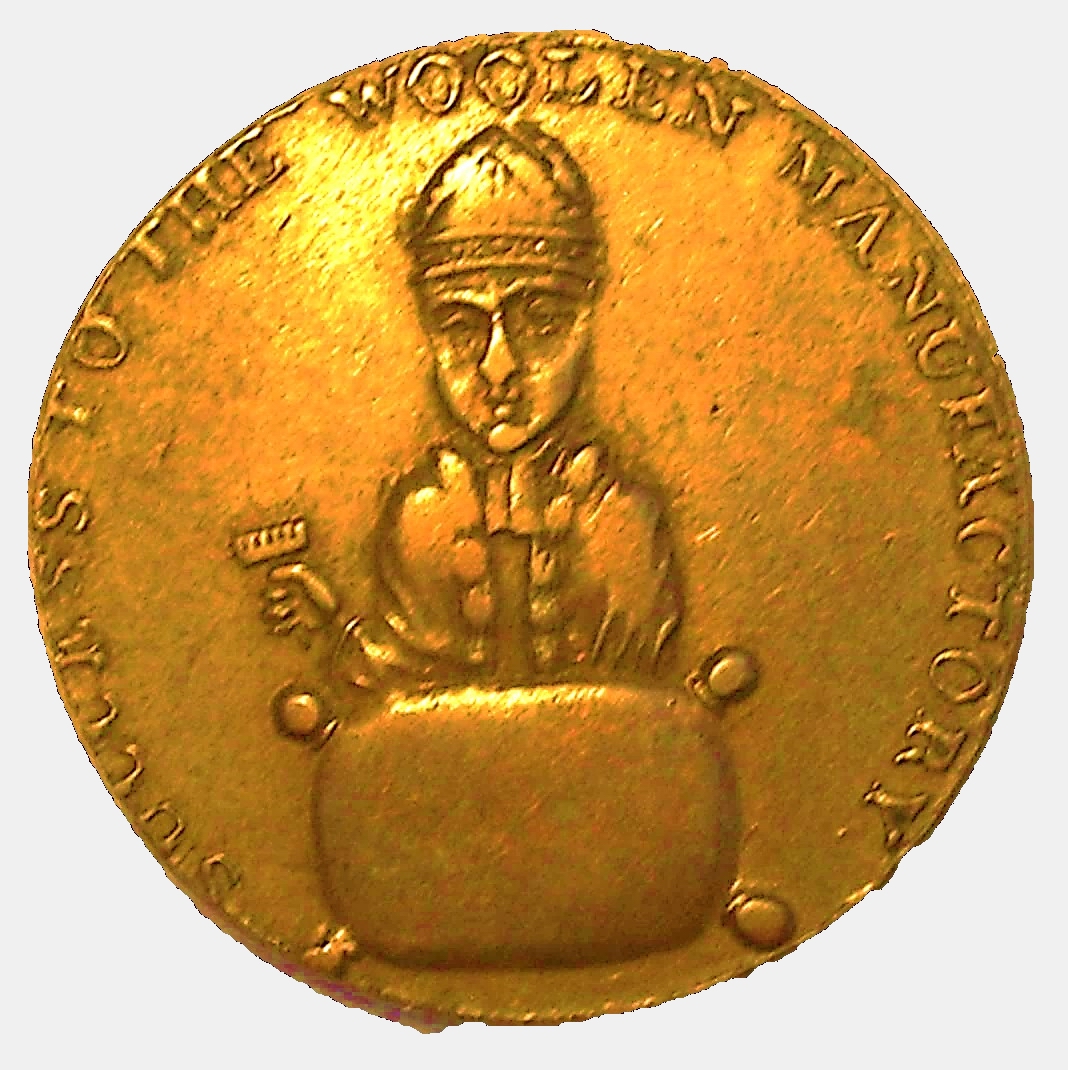
obv ALGLESEA MINES HALFPENNY 1791 around PMCo cypher, reverse: SUCCESS TO THE WOOLEN MANUFACTARY around Bishop Blaize and woolpack, edge plain.
Bishop Blaise was a physician and bishop in Sebastea, Armenia and was believed to have lived around the end of the 3rd or early 4th century The Bishop refused to renounce his faith so was martyred by being beaten, attacked with iron combs, and beheaded by Licinius who was subsequently himself hanged by Constantine 1. He is the patron saint of wool combers and throat disease.
According to the Acts, while Blaise was being taken into custody by Licinius, a distraught mother, whose only child was choking on a fishbone, threw herself at his feet and implored his intercession. Touched at her grief, he offered up his prayers, and the child was cured. Consequently, Saint Blaise is invoked for protection against injuries and illnesses of the throat.
WOOL AND SILK WEAVING
Wool weaving was established in Suffolk as far back as the 14th century, and continued right through into the 18th century. By then the industry in Spitalfields was well established but plagued by frequent industrial disputes between masters and men.
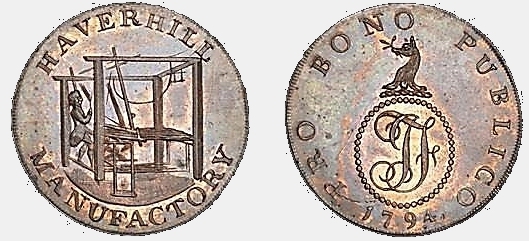
In 1774 the local magistrates in Spitalfields decided to act and began the first of a series of efforts to regulate the local silk industry, deciding to enforce wage levels on masters and men alike. Many masters then began to move production to country areas within easy reach of London but beyond the interference of the London magistrates. And so silk weaving arrived in towns such as Haverhill, Glemsford and Sudbury. Here there were many skilled textile workers who were happy to work at wages that were higher than they could obtain weaving the traditional fabrics but still only two thirds of what the silk masters would have to pay in Spitalfields. In Suffolk, weaving was still practiced as a cottage industry. Handlooms were worked at home, sometimes by agricultural workers to supplement their wages. Master Weavers were middlemen who "put out" work to the cottagers, then collected up the cloth, and acted as distributor of the heavy cloth to be made into agricultural workers clothing. Material was sent to tailors and drapers in East Anglia and East London
A Haverhill token, known as the Fincham halfpenny shows on one side, a man weaving with the inscription "Haverhill Manufactory". On the reverse is the crest of a Hind's head, the date 1794 and the inscription "Pro bono publico." The token also shows the initials, JF, attributed to John Fincham. This token was traded in Hull, South Shields, Chelmsford and London. The loom and motto is still used today, as a badge, by the Haverhill Town Council. John Fincham was a retailer, and the words "Payable at John Finchams - Suffolk" were inscribed around the outer edge of these tokens.
The motto "pro bono publico", was widely used on these tokens across the country in an attempt to demonstrate to the government that the motivation for issue was one of public benefit rather than base profit.
TOKENS IN SUPPORT OF CAUSES
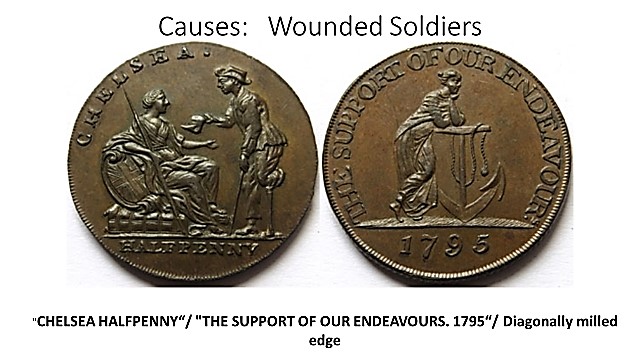
A Chelsea (Middlesex) copper halfpenny token dated 1795. Obverse: View of a beggar with a peg leg presenting a petition to Britannia: "CHELSEA HALFPENNY". Reverse: Roman Goddess Hope leaning against an anchor: "THE SUPPORT OF OUR ENDEAVOURS. 1795". Diagonally milled edge.
Although the issuer is unknown it might be associated with the Chelsea Military Hospital, home of the "Chelsea Pensioners". The token may have been issued as a reminder to the Nation of the debt owed to the army and navy. The defeated troops from the disastrous Flanders Campaign of 1794 would have just returned to England, therefore the obverse could have been designed to attract attention to their plight, while the reverse was a reminder that the navy should also not be neglected.

Portsmouth (Hampshire) copper Conder halfpenny token dated 1795. Obverse: Bust to left of John Howard: “IOHN HOWARD F. R. S PHILANTHROPIST”. Reverse: Britannia seated holding spear and resting on shield: “RULE BRITANNIA 1795”. Edge inscription: “PAYABLE IN LONDON” with the remainder engrailed.
This coin commemorates the work of John Howard FRS (2 September 1726 – 20 January 1790) who was a philanthropist and the first English prison reformer. After a long and varied career John Howard was appointed High Sheriff of Bedfordshire in 1773, initially for a one-year period. Such was his dedication, rather than delegating his duties to the under-sheriff as was customary, Howard inspected the county prison himself. He was shocked by what he found, and spurred into action to inspect prisons throughout England. Of particular concern to Howard were those prisoners who were held because they could not pay the jailer's fee – an amount paid to the owner or keeper of the prison for upkeep. He took this issue to parliament, and in 1774 Howard was called to give evidence on prison conditions to a House of Commons select committee. Members of that committee were so impressed that, unusually, Howard was called to the bar of the House of Commons and publicly thanked for his 'humanity and zeal'.
His final journey inspecting prisons took him into Eastern Europe, and into Crimea. Whilst at Kherson, Howard contracted typhus on a prison visit and died, aged sixty-three in January 1790. The Reform League formed in 1866.
It is not at all clear why Portsmouth issued this coin but similar “Howard “ coins, not always to the same design, were issued by several towns & counties. eg. Bath, Yorkshire, Birmingham,And Somerset.
London (Middlesex) copper Anti-Slavery halfpenny token (circa 1795) modelled after a 1787 medal designed by English potter and fervent abolitionist Josiah Wedgewood.
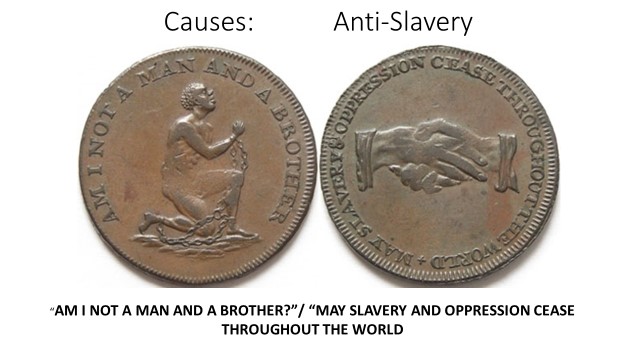
The obverse displays a kneeling man pleading, “AM I NOT A MAN AND A BROTHER?”, while the reverse shows clasped hands with the motto, “MAY SLAVERY AND OPPRESSION CEASE THROUGHOUT THE WORLD” around the periphery.
Made of copper, this token was issued by the Quaker influenced British Society for Suppression of the Slave Trade. In 1787, Wilberforce met up with a group of anti-slave-trade activists. They persuaded Wilberforce to take on the cause of abolition, and he soon became one of the leading English abolitionists. He headed the parliamentary campaign against the British slave trade for twenty-six years until the passage of the Slave Trade Act of 1807. This coin was issued as part of the pressure to change the law.
By 1788, the abolitionist movement in England had substantial influence. That year the British House of Commons passed a bill that limited the number of slaves a ship could carry. In the following years, further bills were introduced and finally, in 1807 slavery was abolished. By 1834, all slaves throughout the British colonies were free.
POLITICAL COINS
These men were prepared to risk their freedom by expressing their opinion.
John Frost, Thomas Hardy, John Thelwall, Thomas Spence, John Horne Tooke, John Binns, John Gale Jones
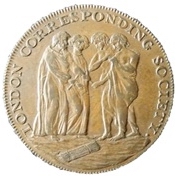

The London Corresponding Society was founded in 1792 in order to spread revolutionary doctrines, similar to those propagated in France following the Revolution, by pursuing political reform through education. It stressed the necessity of government by the people, especially the expansion of the representation of working class people, and highlighted the corrupt method of selection for Parliament,. It also advocated peace with France. It's greatest success was when 150,000 people attended one of their meetings in Copenhagen Fields, London in 1795.
The creators of the group were John Frost (1750-1842), an attorney, and Thomas Hardy, a shoemaker and metropolitan Radical. The society irritated the establishment with its opposition to the wars with France and was deeply infiltrated by spies. .
A British Convention of reform group leaders in Edinburgh organised by the Scottish Friends of the People society in October 1793 was broken up and a number of men were arrested and tried for sedition.
The LCS representatives, Gerrald and Maragot, were sentenced to fourteen years transportation. John Frost received only six months for his sedition. Undaunted, the remaining LCS leaders met with other reformist groups, including the Society for Constitutional Information, in 1794 to discuss a further national convention as well as producing a large number of pamphlets and periodicals. In May 1794 the government took more action: certain of the society leaders were arrested and Hardy, John Thelwall and John Horne Tooke were tried for treason in October, but were acquitted.
The society was not suppressed by these efforts and in 1795 there were a number of public meetings, including one near Copenhagen House attended by a few thousand people. Also King George III's carriage was stoned as he went to open parliament.
The government responded with the so-called Two Acts - an extension of the treason laws with the Treasonable Practices Act and also the Repressive Seditious Meetings Act 1795; detention without trial had already been in force since 1794 when habeas corpus was suspended.
In March 1796 leading LCS men John Binns and John Gale Jones were arrested. In 1798 the society became increasingly split and in 1799 it and several other radical groups were declared illegal under the Corresponding Societies Act. The LCS effectively ended then, although it maintained a vague, informal existence for a little time after. But the ideas had an influence on the 19th century Reform Bills and on Chartism.
THOMAS SPENCE
Thomas Spence was a prolific issuer of tokens advancing the Radical cause. A number of his dies were used to produce several Obverse patterns matched with a single Reverse pattern and vice versa. Examples of his tokens are shown below.
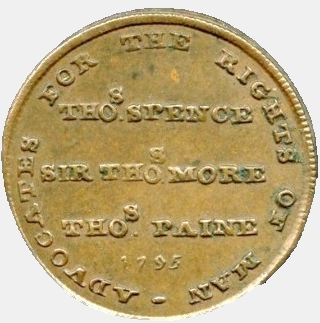
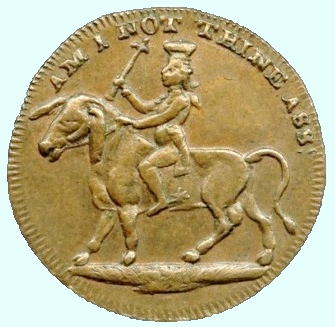
Obverse : ADVOCATES FOR THE RIGHTS OF MEN
THOs SPENCE.SIR THOs MORE. THOs PAINE/
Reverse: AM I NOT THINE ASS
The reverse shows the King riding on as Ass- but implies he is riding on the people.
Below is Thomas Spence’s London (Middlesex) copper halfpenny token dated 1796
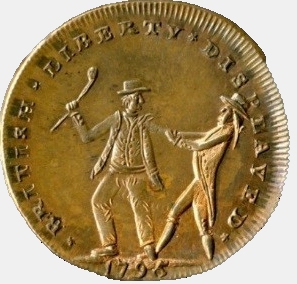
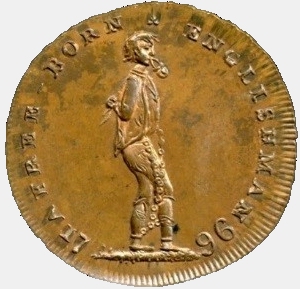
Obverse: A sailor press-ganging a landsman with legend: “* BRITISH * LIBERTY * DISPLAYED * 1796”. Reverse: A FREEBORN ENGLISHMAN 1796 .- With his mouth padlocked and hands bound behind his back.
Spence was one of the leading English revolutionaries of the late eighteenth and early nineteenth centuries. Spence was born in poverty and died the same way in 1814, after long periods of imprisonment. Spence was one of 19 children. His mother, Margaret Flet, sold stockings, his father was a net maker. Spence was an odd, difficult, utterly sincere man. He left Newcastle for London in 1787 where he kept a book-stall in High Holborn. In 1794 he spent seven months in
Newgate Gaol on a charge of High Treason, and in 1801 he was sentenced to twelve months' imprisonment for seditious libel. He died in London on 8 September 1814.
At the centre of Spence's work was his Plan, known as 'Spence's Plan'. The Plan has a number of features, including:
The end of aristocracy and landlords;
All land should be publicly owned by 'democratic parishes', which should be largely self-governing;
Rents of land in parishes to be shared equally amongst parishioners;
Universal suffrage (including female suffrage) at both parish level and through a system of
deputies elected by parishes to a national senate;
A 'social guarantee' extended to provide income for those unable to work;
The 'rights of infants' to be free from abuse and poverty.
He published a weekly news sheet Pigs’Meat ( or”Lessons for the Swinish Multutude .(The private Eye of the day but more revolutionary.)
His handbills were titled “Loose Meat for the Pigs”. He rarely missed an opportunity to lampoon the politics of the day.
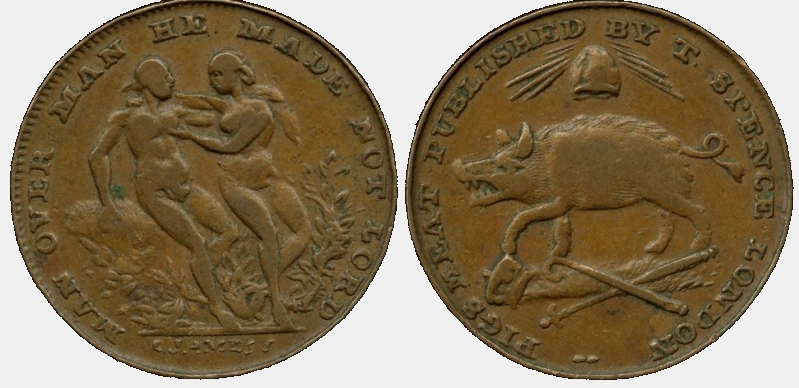
THOMAS SPENCE TOKEN: ADAM AND EVE
MAN OVER MAN HE MADE NOT LORD/ PIG’S MEAT PUBLISHED BY T SPENCE LONDON
Spence explored his political and social concepts in a series of books about the fictional Utopian state of Spensonia. To be a revolutionary in the early decades of the ninteenth century England was to be a Spencean. Despite their humble, 'street-level' origins, Spence's ideas caught on.
A report issued by a Government Secret Committee of 1817 noted that 'the doctrines of the Spencean clubs have been widely diffused through the country either by extension of similar societies or by missionaries.‘
His tracts, such as The Rights of Man (Spence was, perhaps, the first to use the phrase) and The Rights of Infants, along with his utopian visions of 'Crusonia' and 'Spensonia', were the most far-reaching radical statements of the period.
The influence of Spence (even after his death) was taken so seriously that in the same year, 1817, being a Spencean was made illegal. In addition to being a member of the Corresponding society , Thomas Spence was also involved with a shadowy group known as the Loyal Lambeth Association (LLA), which drilled its members in the use of arms. Spence used his tokens to distribute his ideas and was so fond of them that his friends thought it fit to bury him with a couple of his
favourites
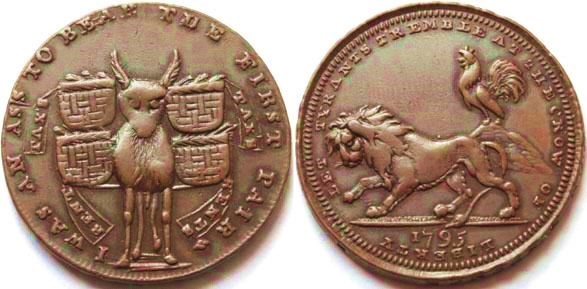
Some of Spences coins are quite hard hitting such as this coin, above, commenting on how Spence saw the lot of the common man.
Obverse: Front view of a rather unhappy Ass loaded with two panniers labelled “TAX'S” and “RENTS” with the legend: “I WAS AN ASS TO BEAR THE FIRST PAIR”. Reverse: Lion with crowing cockerel and legend: “LET TYRANTS TREMBLE AT THE CROW OF LIBERTY 1795”
Following this, at a time when the French Revolution was in full swing he produced the token below. The government would not have liked this coin.
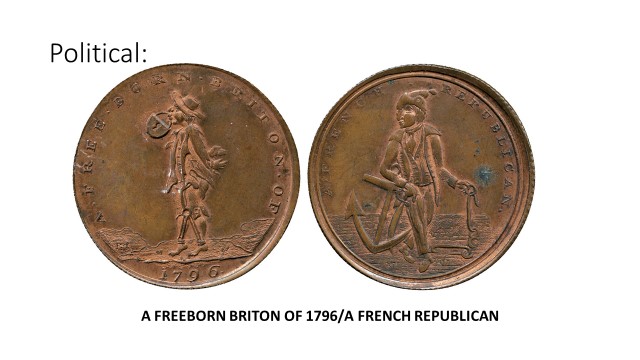
Obverse: A FREEBORN ENGLISHMAN OF 1796 .Shackled with his mouth locked. On the reverse: FRENCH REPUBLICAN with a sailor – Free and holding his broken shackles.
Thomas Paine was another radical who had views on the Rights of Man at the same time as Spence. This token below is a Macabre and cynical Political token produced by Spence.
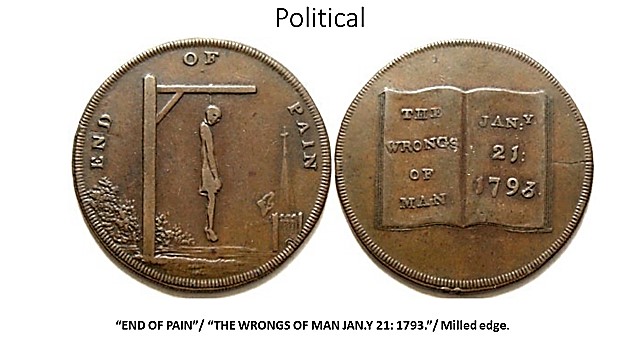
Obverse: A man hanging on a gibbet with a church in the distance flying a flag: “END OF PAIN”. Reverse: An open book with text which reads: “THE WRONGS OF MAN JAN.Y 21: 1793.”.
The obverse design is a pun directed at the reformer Thomas Paine indicating the fate that could befall him. In the event, Paine returned to America in 1802 and died there in 1809. The reverse design parodies Paine's book “Rights of Man” with the “Wrongs of Man”, with the date referring to the execution of Louis XVI of France, and the declaration of the Republic.
Spence pushes this point harder with the Token below.
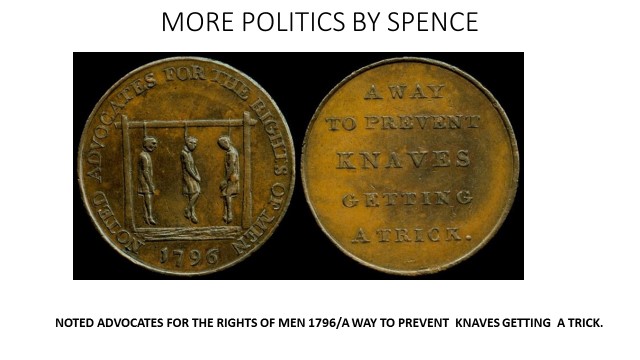
Obv:NOTED ADVOCATES FOR THE RIGHTS OF MEN 1796, three men hanging on a gibbet.
Rev: A WAY | TO PREVENT | KNAVES | GETTING | A TRICK.
Thomas Spence also had an interest in International Politics. This shows a THOMAS SPENCE designed Halfpenny, 1794 Obverse. A MAP OF FRANCE 'Honor' trodden underfoot, 'throne' turned upside down, 'FRA-NCE' (divided), 'RE|LI|GI|ON' cut in pieces, 'GLORY' defaced, 'FIRE' in each corner, murder (i.e. daggers) on every side, and bloodshed all. 1794. Reverse MAY/ GREAT BRITAIN/ EVER REMAIN/ THE REVERSE in an oak wreath.
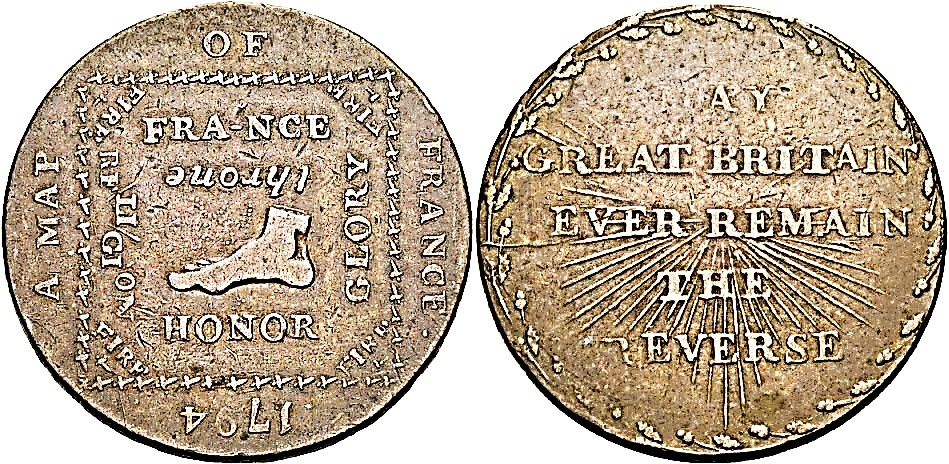
A token to urge the populace to avoid the revolutionary tendency of France
BILL OF RIGHTS 1794 This next halfpenny token was issued by radicals advocating personal liberty. One side of the token shows two barristers holding banner. Above them is the words
"MAGNA CHARTA" The banner the two barristers are holding has the legend "BILL OF RIGHTS". The reverse gives the names of the Corresponding society members charge with sedition.

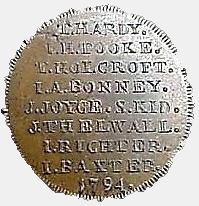
ERSKINE AND GIBBS AND TRIAL BY JURY/ T HARDY. I.H.TOOKE. T HOLCROFT. LA BONNEY. J JOYCE . S KID. J THELWALL. JT HELLWALL. I RICHTER. I BAXTER 1794
The lawyers are holding banners MAGNA CARTA BILL OF RIGHTS
There was a name (and a living) to be made in conducting the defence of such radicals. For two such counsels, Thomas Erskine and Vicary Gibbs, the possibility of spreading this reputation and their availability for business through tokens also appealed. The above piece is certainly a celebration of their skill at the bar and the rights of the free man in English law. It definitely served as advertising too.
JOHN THEWALL
Below shows Thomas Spence’s London (Middlesex) copper halfpenny token undated. The coin celebrates the work of another Radical, John Thelwall.
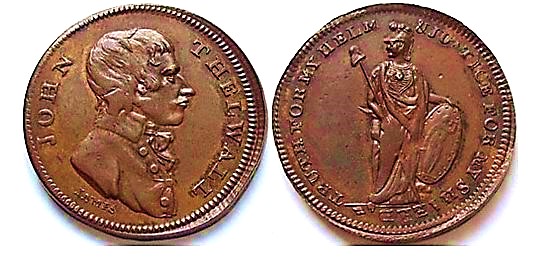
Obverse: Bust of John Thelwall to right with legend: “JOHN THELWALL”. Reverse: Standing figure of Minerva Roman goddess of wisdom and sponsor of arts, trade, and strategy. holding cap of liberty on pole and Justice on her shield with legend: “TRUTH FOR MY HELM & JUSTICE FOR MY SHIELD”. Plain edge.
John Thelwall was a vociferous supporter of reform and was subsequently persecuted by the Government on many occasions. Thelwall was born in Covent Garden, London, but was descended from a Welsh family. He was the son of a silk merchant, who died in 1772 leaving the family in economic distress. It was not until 1777, though, that John had to leave school to help his mother, who had decided to keep the silk business running.
Thelwall's fondness for books showed up at an early age, earning him the scorn of his mother. It also made it impossible for him to fulfil an apprenticeship as a tailor. Thelwall also tried to make a living in an attorney office, but his morals and eccentricity made him quit the job and try to depend on his writing.
Thelwall's career as an editor and journalist was quite successful, but the highlight of this period was his political activism. He started to hold talks in London's radical societies and, having made acquaintance with fellow radical John Horne Tooke, contributed to the founding of the London Corresponding Society in 1792. In 1794 he, Horne Tooke and Thomas Hardy were tried for treason following lectures protesting the arrest of other political activists. After spending some time at the Tower and at Newgate, the three were acquitted. Government officials who considered him to be the most dangerous man in Britain continued to hound him even after his acquittal.
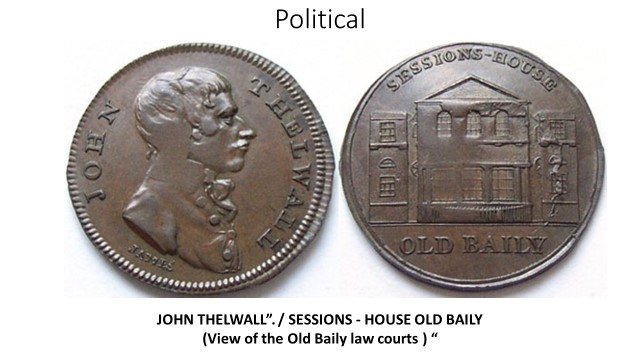
Another coin above, sponsored by Thomas Spence also celebrates John Thewell and his trial for treason at the Old Baily.
Obverse: Bust of John Thelwall to right with legend: “JOHN THELWALL”. Reverse: View of the Old Baily law courts with legend: “SESSIONS - HOUSE OLD BAILY”. Plain edge.
DANIEL EATON
Daniel Isaac Eaton (1753-1814) was an English radical author, publisher and activist. His bookshop functioned as an important rendezvous for radicals living in London. He was prosecuted eight times between 1793 and 1812, finally being convicted over his printing of Paine's Age of Reason.
The coin below shows a Gamecock, crowing on a fence above Pigs in a Sty.

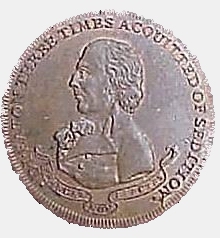
D I EATON THREE TIMES AQUITTED OF SEDITION
FRANGAS NON FIECTES (You may break me, but you will not bend me,)/
PRINTER TO THE MAJESTY OF THE PEOPLE. LONDON. 1795
One of Eaton’s arrests was on 7 December 1793 for publishing a statement by John Thelwall, a radical lecturer and debater: Thelwall had made a speech that included an anecdote about a tyrannical gamecock named "King Chanticleer" who was beheaded for its despotism. Note, on the token, the Gamecock (King Chanticleer) crowing over 3 pigs one of whom is holding up an open book The authorities took this to refer to the King and therefore seditious.
Eaton was imprisoned for three months before his trial in an effort to bankrupt him and his family. In February 1794, he was finally brought to trial and defended by John Gurney: he was acquitted. Gurney argued that the speech had been an indictment of tyranny in general or of Louis XVI, the king of France, and announced his dismay that anyone could think that anyone meant George III.
"Gurney went so far as to cheekily suggest that it was the Attorney-General who was guilty of seditious libel; by supplying those innuendos he, not Eaton or Thelwall, had represented George III as a tyrant.” Everyone laughed uproariously and Eaton was acquitted.
The London Corresponding Society rewarded each juror in the third case with a silver medal and Eaton himself issued a halfpenny token with himself as hero. !!
Unfortunately, Eaton continued to support the Radical cause. He was tried again in 1795 for publishing "Female jockey club" denouncing the opulence of the aristocracy amidst 'deplorable wretchedness‘, and in 1796 for publishing "Political dictionary" and "Duties of citizenship".
His luck ran out, he was found guilty of libel, escaped to the US but had the bad sense to return to Britain 3 years later. He was promptly arrested, spent 15 months in prison and had his stock, worth £28 000 burnt.
In 1812 he was again found guilty, this time of publishing Paine's "Third part of the age of reason". He spent 18 months in Newgate prison and died impoverished a few years later.
THOMAS HARDY
Thomas Hardy was born on 3 March 1752 in Larbert, Stirlingshire, Scotland, the son of a merchant seaman. His father died in 1760 at sea while Thomas was still a boy.
Around 1792, Thomas Hardy was one of those who founded the London Corresponding Society, starting out with just 9 friends. Two years later it had grown so powerful that he was arrested by the Crown on charges of high treason. It was during his imprisonment that Hardy's wife died, leaving him with an unfinished letter declaring her love for him.
The charges were prosecuted with Sir John Scott leading for the Crown, and William Garrow among the prosecuting counsel; while Hardy was defended by Thomas Erskine.
He was acquitted with his two companions after 9 days of testimony and debate on Guy Fawkes Day, 1794.

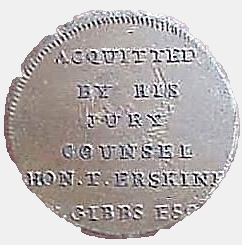
TRIED FOR HIGH TREASON 1794/AQUITTED BY HIS JURY/COUNSEL HON.T. ERSKINE V GIBBS ESQ
.In later life Hardy ceased involvement in politics, and with the assistance of friends set up a small shoe shop in Tavistock Street, Covent Garden and in September 1797 he moved to a smaller establishment in Fleet Street. He died on 11 October 1832
JOHN HORNE HOOKE
John Horne TOOKE was born in Newport Street, Long Acre, Westminster, the third son of John Horne, a poulterer in Newport Market. In January 1754 he was admitted at St John's College, Cambridge, and took his degree of B.A. in 1758, His father wished him to take orders in the Church of England, and he was ordained deacon on 23 September 1759 and priest on 23 November 1760.
In 1776 Horne found himself involved in serious trouble for his conduct in signing the advertisement soliciting subscriptions for the relief of the relatives of the Americans "murdered by the king's troops at Lexington and Concord," he was tried at the Guildhall on 4 July 1777, found guilty, and committed to the King's Bench Prison in St George's Fields, from which he only emerged after a year's imprisonment, and after a loss in fines and costs amounting to £1200. He published further radical pamphlets in 1782 attacking the Government.
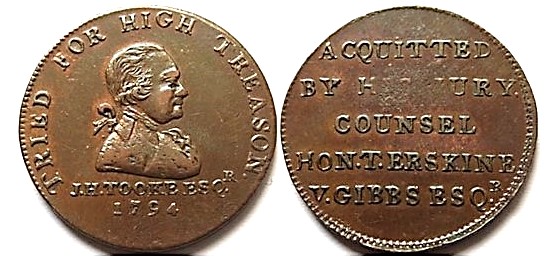
Obverse: Bust of John Horne Tooke to right: “TRIED FOR HIGH TREASON J. H. TOOKE ESQ. 1794”. Reverse: Legend on five lines: “ACQUITTED BY HIS JURY. COUNSEL HON. T. ERSKINE V. GIBBS ESQR.”.
At the general election of 1790, Horne Tooke came forward as a candidate in opposition to Fox and Lord Hood, but was defeated; and, at a second attempt in 1796, he was again at the bottom of the poll.
In the meantime, the excesses of the Republicans in France had provoked reaction in England, and the Tory ministry adopted a policy of repression to ensure their tactics did not take root here . Tooke was arrested early on the morning of 16 May 1794, and conveyed to the Tower of London.
His trial for high treason lasted for six days (17 to 22 November) and ended in his acquittal, the jury taking only eight minutes to settle their verdict.
After his trial he stood for parliament and was elected as the member for Old Sarum . The government did not like this and they passed a bill carried into law, which rendered all persons in holy orders ineligible to sit in the House of Commons. ( This bill was repealed in 2001) The parliamentary life of the member for Old Sarum was preserved through one parliament, but at its expiration he was excluded for ever.
JOHNATHON DENNIS
There were others, less revolutionary, who wanted to celebrate changes to the law by issuing coins. The Bakers Halfpenny below is an example of this. It was struck at the instigation of Jonathan Dennis, a master baker on Tottenham Court Road

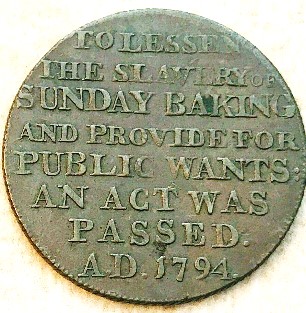
Obverse: Central wheatsheaf, BAKERS HALFPENNY 1795 Reverse:: TO LESSEN THE SLAVERY OF SUNDAY BAKING AND PROVIDE FOR PUBLIC WANTS: AN ACT WAS PASSED. A.D. 1794.
Eighteenth Century Bakers were exempt from Charles II law ( Sunday Observance Act) because their ovens were important for cooking the Sunday meal. This Token was struck to commemorate an act of Parliament which gave relief to overworked apprentice and journeyman bakers by limiting the hours by which the baking and selling of baked goods could take place on a Sunday.
POLITICAL/COMMERCIAL

MORE TRADE AND FEWER TAXES/PROSPERITY TO OLD ENGLAND
This coin shows Richard Dinmore’s Norwich (Norfolk) copper halfpenny token undated. Dinsmore was a member of the Norwich Patriotic Society , an regional clone of the Corresponding Society. He had a business as a saddler’s ironmonger and hemp merchant at Timber Hall, Norwich.
COMMERCIAL COINS
A few examples of the very many commercial coins issued are shown below providing examples of how traders sought to advertise their wares via the coinage freedoms.
WHALING

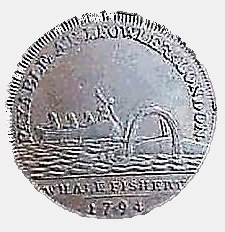
Obverse: Head of the sea god Neptune with trident across shoulder, “HALFPENNY”.
Reverse: Whale fishing scene, four men in a small boat harpooning whales by hand, “PAYABLE AT I FOWLER’s LONDON WHALE FISHERY 1794”. Plain edge.
The issuer is thought to have been John Fowler, an oil merchant and tinplate worker with a business at 78, Long Acre, at the West End of London
GROCERIES
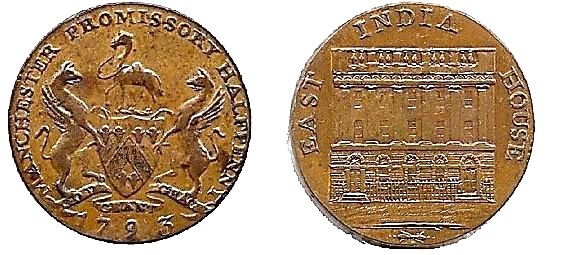
The East India Co. Tea Trading.
MANCHESTER PROMISSARY HALFPENNY (With GOD GRANT GRACE on the crest), and 1793/
EAST INDIA HOUSE
Manchester also turned to this alternative form of making money and promoting trade in the area. From 1792, halfpennies were issued by 'I. Fielding' featuring a fine representation of the Grocers' Arms crest on the obverse. The reverse showed a detailed view of the East India House, possibly to convey the idea that exotic products were now easily available. Manchester was advertising its links to world trade and the Issuer, Fielding was advertising his tea products.
The Grocers Company was founded in the fourteenth century as the Guild of Pepperers, which dates from 1180. The Company was responsible for maintaining standards for the purity of spices and for the setting of certain weights and measures. Its members included London's pharmacists, who separated into the Worshipful Society of Apothecaries in 1617.
The guild was known as the Company of Grossers from 1373 until 1376 when it was renamed the Company of Grocers of London. In 1428, two years after founding its first hall in Old Jewry, the Company was granted a Royal Charter by King Henry VI of England.
It is one of the Great Twelve City Livery Companies, ranking second in the Companies order of precedence after the Mercers' Company.
It is said that the Grocers' Company used to be first in the order, until Queen Elizabeth I, as Honorary Master of the Mercers' Company, found herself in procession, after her coronation, behind the Grocers' camel which was emitting unfortunate smells. As a result, the Mercers were promoted.
The Ancient Guild of Pepperers chose a camel as its symbol. Black pepper is one of the world's most popular spices and has been for centuries. Peppercorns have at times been considered portable wealth. Pepper originally came over land, and this is the reason for the choice of the camel as a symbol. The camel is incorporated into the coat of arms of the Worshipful Company of Grocers, which also includes two griffins holding a shield.
POSTAL SERVICES
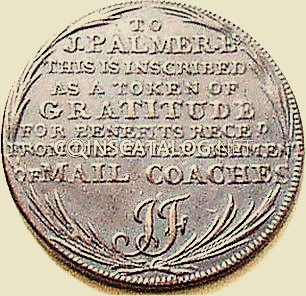

The words on the coin are:-
To J.PALMER.Esq THIS IS INSCRIBED AS A TOKEN OF GRATITUDE FOR BENEFITS RECE'D FROM THE ESTABLISHMENT OF MAIL COACHES JF The initials are probably those of James Fittler, who is also known to have engraved a portrait of Palmer.
Reverse: MAIL COACH HALFPENNY.TO TRADE EXPEDITION
& TO PROPERTY PROTECTION. PAYABLE IN LONDON·
Palmer was the eldest son of a prosperous Bath brewer and theatre owner. Palmer worked as his father's London agent, frequently travelling between his theatres in London and Bath.. Palmer had to move his actors, stagehands and props quickly between Bristol and Bath, he set up a coach service which provided safe, quick and efficient transport for his actors and materials.
The postal delivery service in Britain had existed in the same form for about 150 years—from its introduction in 1635, mounted carriers had ridden between "posts" where the postmaster would remove the letters for the local area before handing the remaining letters and any additions to the next rider. The riders were frequent targets for robbers, and the system was inefficient.
Because Palmer made much use of stagecoach services between cities in the course of his business, it occurred to him that this coach service could be developed into a national mail delivery service, so in 1782 he suggested to the Post Office in London that they take up the idea.After some opposition eventually the Chancellor of the Exchequer, William Pitt, agreed. Under the old system the journey had taken up to 38 hours. The coach, funded by Palmer, took just 16 hours.
BOOK SHOPS

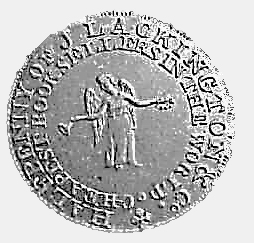
J LACKINGTON 1794 /HALFPENNY OF J LACKINGTON Co:
CHEAPEST BOOKSELLERS IN THE WORLD
Rim legend: Payable at the Temple of the Muse's
James Lackington Halfpenny 1795. James Lackington (Born in Wellington, Somerset, 31 August 1746; died 22 November 1815 in Budleigh Salterton, Devon) was a bookseller who is credited with revolutionizing the British book trade. A shoemaker's son trained as a cobbler, he showed early initiative, selling pies and cakes in the street when aged 10. Lackington taught himself to read and arriving in London in August 1773 with two shillings and sixpence, eventually became a wealthy man.
He is best known for refusing credit at his shop – no exceptions – and by instead receiving cash in return for every item was able to reduce the price of books throughout his store
James Lackington’s bookshop in Finsbury Square. Lackington became one of the largest shops in early nineteenth century London. He was was known as “the father of cheap bookselling and ‘cheap reprinting,” but his premises were anything but cheap. His bookshop, ‘The Temple of the Muses,’ was built between 1789 and 1791. His ‘ware room’, with innovative cast-iron columns, which supported four book-lined circular galleries, fitted into the base of the dome and lit by a cupola, dominated the center of the building.
His love of books is exemplified in the tale that, soon after arriving in London with his wife, he spent their last Half-crown on a book of poems. He explained "if I had bought a dinner we should have had it tomorrow and the pleasure would be over; but should we live fifty years we shall have these poems to feast on."
Coins advertising Places
Making these tokens was a nationwide activity. Towns and counties took to the task with enthusiasm. A few examples are given below.
ST ALBANS


Obverse: Payable at St Albans Herts 1796 with Prince of Wales’ crest and motto, Reverse: crown within radiated Circle
COVENTRY

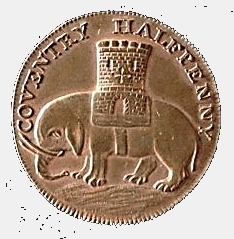
Armorial bearings of the city of Coventry. On the edge “PAYABLE AT BIRMINGHAM LONDON OR BRISTOL” or “PAYABLE AT THE WAREHOUSE OF ROBERT REYNOLDS & CO”.. .Reynolds & Co. were ribbon weavers in Coventry.
This coin celebrates the world’s most famous tax protest, the fabled and likely fictitious 11th century ride of Lady Godiva, wife of Leofric, Earl of Mercia in Anglo-Saxon England.
The story of the lady’s naked ride was first recorded in Roger of Wendover’s 13th century book Flores Historiarum or Flowers of History. Despite its title, the book is a chronicle of events not a gardening guide.
The tale has been enhanced over the centuries, but the plot remains the same: Leofric refused Godiva’s entreaties to lower the taxes on the oppressed residents of Coventry. One day, though, Leofric gives in, saying he’ll cut taxes if she rides naked through the town at midday.
“The rest of the story is not documented at all, but it is said that so great was her compassion for the people of Coventry that Godiva overcame her horror of doing this. She ordered the people to remain indoors with their windows and doors barred. Loosening her long hair to cover her as a cloak, she mounted her waiting horse.
“Then she rode through the silent streets unseen by the people, who had obeyed her command because of their respect for her.”
Peeping Tom, the tailor who was struck blind for looking, was added to the story in the 17th century.
The scholarly works all say that the elephant was granted to Coventry with its city charter from King Edward , in recognition of its historic connection with St. George (place of birth, marriage or burial according to various medieval monks/scribes).
It seems the elephant was the enemy of the dragon in medieval bestiaries (remember, both the elephant and the dragon were rarely seen in England in those days and were probably considered equally mythical), St George being the dragon slayer, he was a hero to elephants, too, hence the elephant on Coventry's crest.

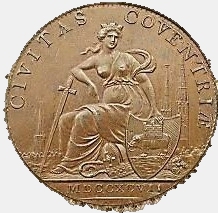
In this other Coventry coin Obverse: Peeping Tom is shown looking out of a building (top left). Memorae Godivae 1757 in exerge.
Reverse:Britannia is shown with the Coventry Shield. Civitas Coventria around. In exerge:MDCCXCVII
. STORTFORD

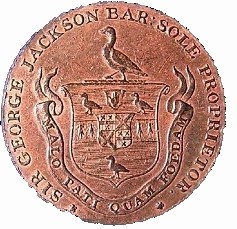
SIR GEORGE JACKSON BAR: SOLE PROPRIETOR (MALO PATI QUAM FOEDAM ) /
STORT NAVIGATION SOURCE OF TRADE 1795
Sir George Jackson, who in 1795 issued the Stortford Halfpenny token for use on the Stort Navigation and made it redeemable for conventional money at the company’s offices at Swan Dock. The tokens were originally produced at the Soho Mint in Birmingham..
On the obverse side are depicted the Arms of the Jackson and Duckett families. The Sheldrakes represent the Arms of the Jackson family and the St Andrew’s Crosses and sprays of lavender are the Duckett Arms. The hand signifies a baronet and the Latin motto translates ‘I would rather suffer than defile’. The reverse side depicts a view of the river Stort with a horse drawn barge in the foreground. Several variations of the token were issued, one design having a plain rim while another has the words ‘Payable at Bishop’s Stortford’.
PETERSFIELD

Obverse: Man on horseback,Legend: PETERSFIELD Reverse: Stork, Legend: PROMISSORY HALFPENNY 1793 Edge Legend -Eames,Holland and Andrews Petersfield
Obverse, shows a mounted dragoon soldier carrying a sword while on the reverse is a bird on a tuft of marshy ground, which is officially described as a stork but could be a heron – a bird long associated with the Petersfield area.
This token served three tradesmen, all with businesses in Petersfield. As late as 1860 there was a Henry Eames, watchmaker, in the town. The names of Holland and Andrews seem to have disappeared. The right of election was restricted to the freeholders of lands, or old dwelling houses, or shambles, built upon ancient foundations within the borough. At the time the token was issued all this property belonged to one man and therefore the nomination of Members of Parliament rested entirely with him. In the days of coaching and posting Petersfield derived much of its wealth from travellers, as the town lay on the highroad from Portsmouth to London.
Counties
KENT
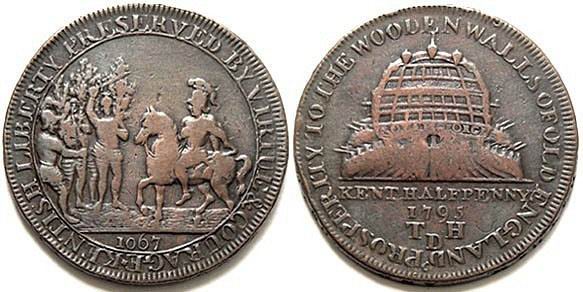
Kentish men (one with a sword upraised, another with a bow) on left, meeting William the Conqueror on horseback on Lettering: KENTISH LIBERTY PRESERVED BY VIRTUE & COURAGE .Edge Payable at Thomas Haycraft ( An ironmonger)
Kent did not submit to Norman rule until their rights and privileges had been acknowledged and unmolested. As a result, Kent became a semi-autonomous County Palatine under William's half-brother Odo of Bayeux. Odo destroyed and plundered the landowners of Kent, amassing a huge fortune in both land and gold. He forcibly seized lands for his friends and family Odo's tyrannical behaviour made him many enemies in Kent, and it was only a matter of months before his severity drove the county into open revolt in 1067. The Kentish men Petitioned William as shown in the scene on the coin.
Reverse:A stern view of a man-of-war ship with name “Royal George” in middle, legend around and in exergue, toothed border.
PROSPERITY TO THE WOODEN WALLS OF OLD ENGLAND
ROYAL GEORGE
KENT HALFPENNY 1795 T H D
HMS Royal George was a 100-gun first-rate ship of the line of the Royal Navy, built at Woolwich Dockyard and launched on 18 February 1756. The largest warship in the world at the time of launching, she saw service during the Seven Years' War including being Admiral Sir Edward Hawke's flagship at the Battle of Quiberon Bay and later taking part in the Battle of Cape St Vincent.
She sank undergoing routine maintenance work whilst anchored off Portsmouth on 29 August 1782 with the loss of more than 800 lives, including 300 women and 60 children visiting the ship. One of the most serious maritime losses to occur in British waters.
Lancaster (Lancashire)

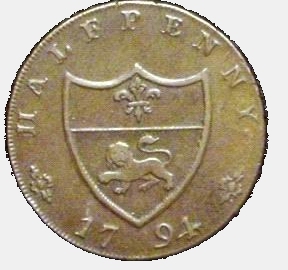
Obverse: Bust of John of Gaunt, legend: “IOHN OF GAUNT DUKE OF LANCASTER”. Reverse: Shield “LANCASTER HALFPENNY 1791”. Edge inscription: “PAYABLE AT THE WAREHOUSE OF THOS WORSWICK & SONS .X.”.
Worswick and Sons appear to have been gold and silver smiths, watchmakers and jewellers in New Street, Lancaster, as well as being bankers. John of Gaunt, the fourth son of Edward III, was born at Ghent (Gaunt) around 1340 and was later made the Duke of Lancaster. His son by his first wife, Blanche, later became Henry V.
1794 Sussex Half-Penny Token-
Obverse: FOR THE CONVENIENCE OF SOCIETY
Reverse: HALFPENNY TOKEN PAYABLE AT EDGE: PAYABLE AT JOHN FOLLERS NORTHIAM
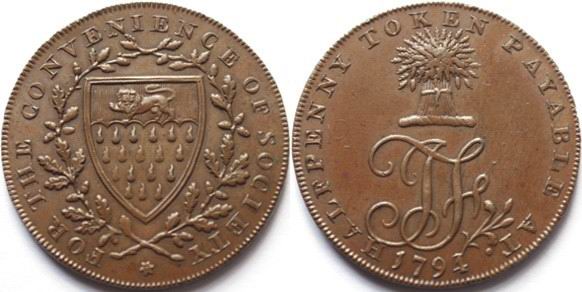
Middlesex halfpenny 1795 Coventry Street
OBVERSE: A filtering stone. FOR PURIFYING WATER. Ex: 1795. REVERSE: THE FILTERING STONE WARE-HOUSE * COVENTRY STREET LONDON. EDGE: Plain
.jpg?timestamp=1592068365518)
.jpg?timestamp=1592068398159)
Water was poured into a depression in the stone which was made of sandstone. The water percolated through slowly at the rate of about one gallon an hour. At the time impure water was a major cause of disease.
COUNTY/PEOPLE
Warwickshire
Obv: Bust of William Shakespeare facing left, legend around WARWICKSHIRE. Rev: female figure seated, supporting a cornucopia, bow of ship in background, date in exergue HALFPENNY 1791

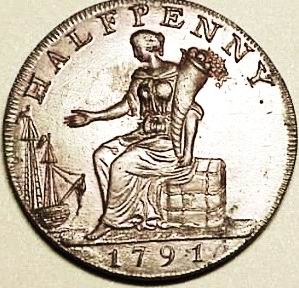
London ( Middlesex)
Obverse: Bust to left with legend: “SR. ISAAC NEWTON”.

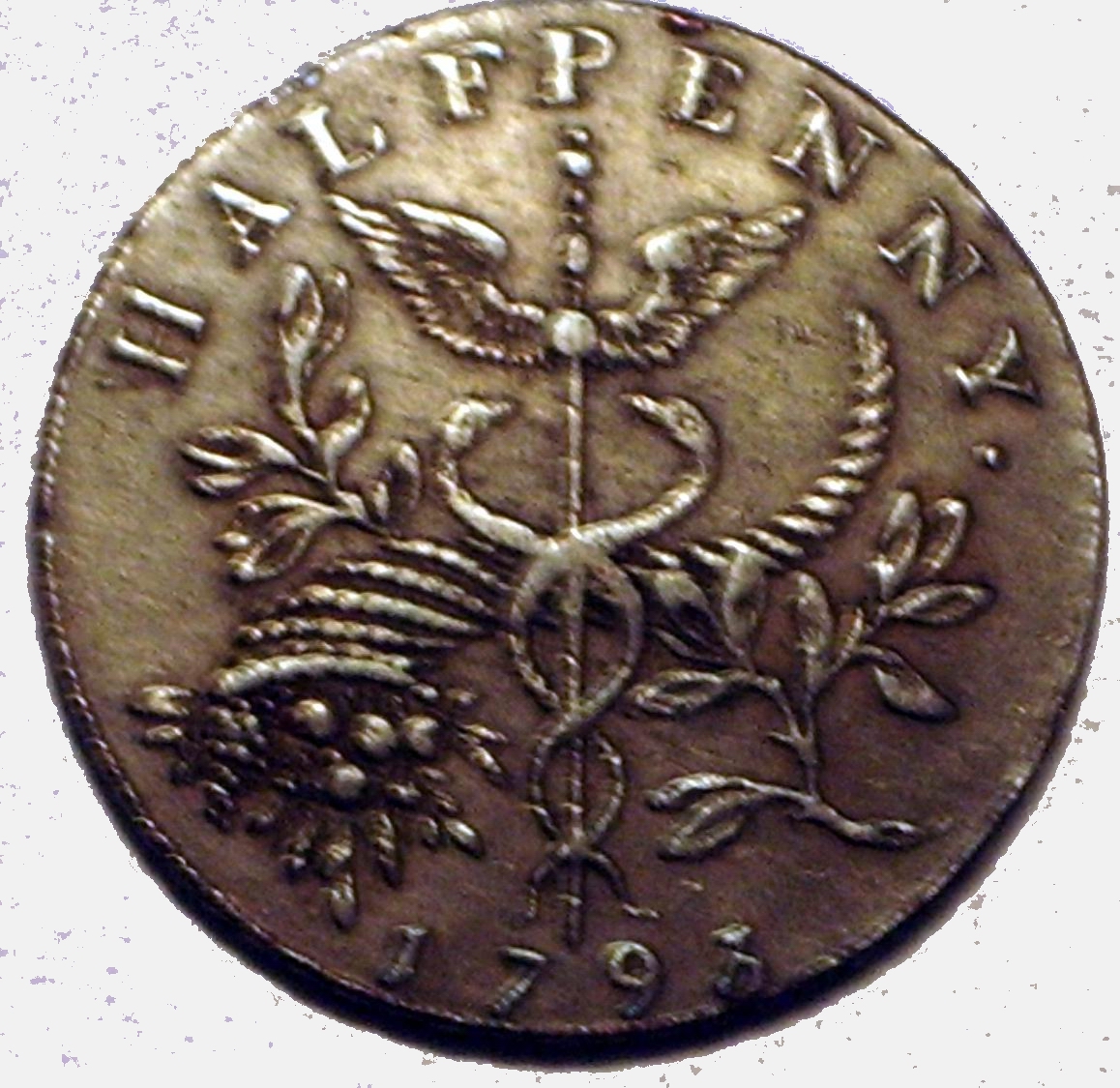
Reverse: Winged caduceus with intertwined serpents, olive branch and cornucopia with legend: “HALFPENNY 1793” The two-snake caduceus design has ancient and consistent associations with trade, eloquence, negotiation, alchemy and wisdom. In addition to being Astronomer Royal and famous scientist, Sir Isaac Newton was also Master of the Royal Mint for a time, then situated in the Tower of London
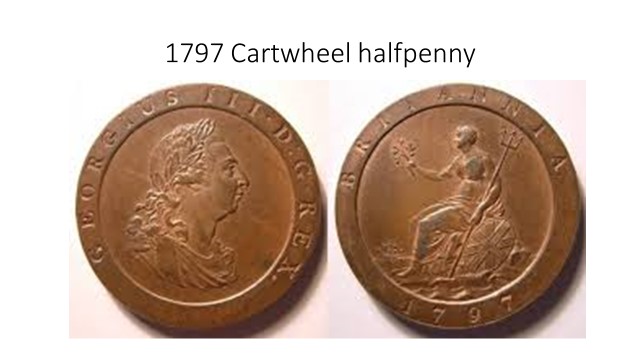
By 1795, the supply of these tokens — real ones, spurious pieces, and medalets — exceeded demand. The quality had deteriorated to the point where something had to be done. The government finally stepped in, and called a halt to the tokens.
In 1797 George III contracted Matthew Boulton of the Soho mint in Birmingham to produce large two pence and penny coins known as "cartwheels," because of their wide extruding rim. Boulton designed these coins so they would be difficult to counterfeit. Certainly the cost of the copper exceeded the value of the coin so counterfeiters had nothing to gain.
These giants, containing respectively a penny and two-pence worth of copper, were unique in having the inscription impressed on to the surface as opposed to being raised up. They demonstrate the power of the newly introduced steam-powered presses. (Note Brittania with trident to advertise England Naval power.)
For a ten year period extending from 1787-1797 almost the only “coins” in circulation in Britain had been the Provincial, or tokens. As they were designed and manufactured by the public, they were not limited by any rules or regulations. Taken as a group, the tokens form a history of a people in a way never seen before — or since!! Through them, we can look in on life in late 18th century Britain. We can see how they lived and thought through their commerce, politics, advertising, and even view their architecture.
In the early 19th Century, the Royal Mint bought steam engines and coin presses from Boulton, ending the minting of British coins in Birmingham and re- establishing Regal coinage.
It was not until after the death of George III in 1820 and the accession of his son George IV that the copper coinage was recommenced. Coinage of pennies and halfpennies resumed in 1825
By the late 1850s, the state of the copper coinage was deemed unsatisfactory, with quantities of worn oversized pieces, some dating from Boulton's day, still circulating.
They were replaced by lighter bronze coins beginning in 1860; An example of the last English copper coin is shown below

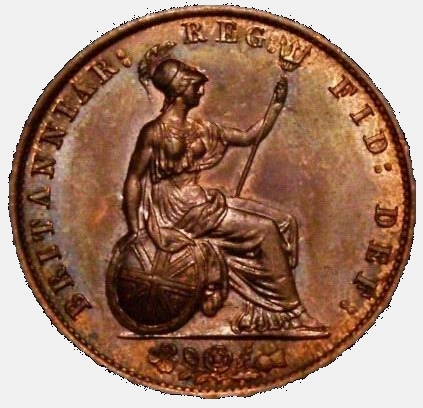
Thus ended the era of English copper coins 1614-1860.
ADDENDUM
This book was produced as a Coronavirus lockdown project in April 2020. The topic is about the Tokens and Coins that I have collected for many years, though a number of Coins and Tokens I do not possess are featured in the book. It was relies heavily upon material found on the Internet, particularly for the historical accounts. I believe this material to be in the public domain.
John Prior (Ed)
© Copyright English Copper coins